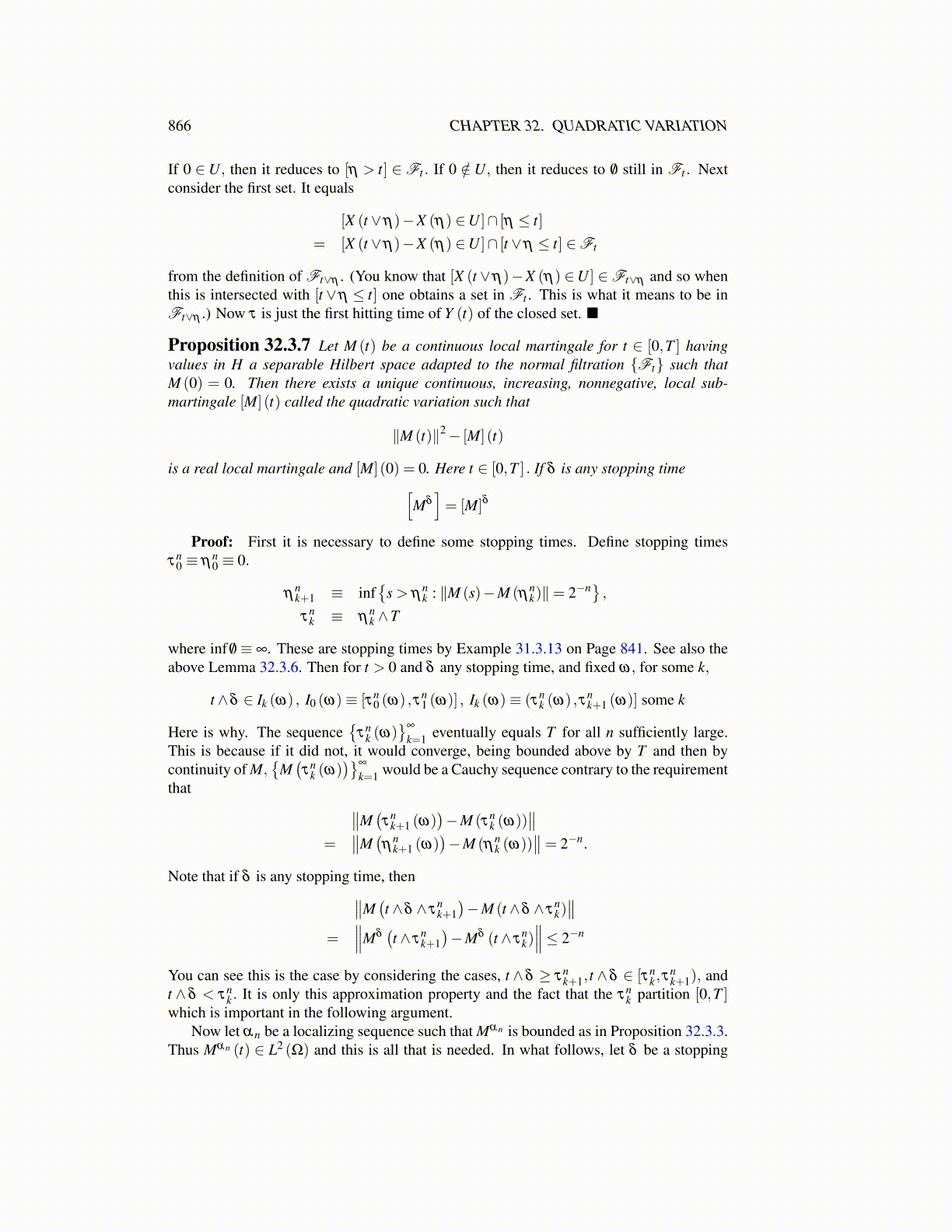
866 CHAPTER 32. QUADRATIC VARIATION
If 0 ∈U, then it reduces to [η > t] ∈Ft . If 0 /∈U, then it reduces to /0 still in Ft . Nextconsider the first set. It equals
[X (t ∨η)−X (η) ∈U ]∩ [η ≤ t]
= [X (t ∨η)−X (η) ∈U ]∩ [t ∨η ≤ t] ∈Ft
from the definition of Ft∨η . (You know that [X (t ∨η)−X (η) ∈U ] ∈Ft∨η and so whenthis is intersected with [t ∨η ≤ t] one obtains a set in Ft . This is what it means to be inFt∨η .) Now τ is just the first hitting time of Y (t) of the closed set. ■
Proposition 32.3.7 Let M (t) be a continuous local martingale for t ∈ [0,T ] havingvalues in H a separable Hilbert space adapted to the normal filtration {Ft} such thatM (0) = 0. Then there exists a unique continuous, increasing, nonnegative, local sub-martingale [M] (t) called the quadratic variation such that
∥M (t)∥2− [M] (t)
is a real local martingale and [M] (0) = 0. Here t ∈ [0,T ] . If δ is any stopping time[Mδ
]= [M]δ
Proof: First it is necessary to define some stopping times. Define stopping timesτn
0 ≡ ηn0 ≡ 0.
ηnk+1 ≡ inf
{s > η
nk : ∥M (s)−M (ηn
k)∥= 2−n} ,τ
nk ≡ η
nk ∧T
where inf /0 ≡ ∞. These are stopping times by Example 31.3.13 on Page 841. See also theabove Lemma 32.3.6. Then for t > 0 and δ any stopping time, and fixed ω, for some k,
t ∧δ ∈ Ik (ω) , I0 (ω)≡ [τn0 (ω) ,τn
1 (ω)] , Ik (ω)≡ (τnk (ω) ,τn
k+1 (ω)] some k
Here is why. The sequence{
τnk (ω)
}∞
k=1 eventually equals T for all n sufficiently large.This is because if it did not, it would converge, being bounded above by T and then bycontinuity of M,
{M(τn
k (ω))}∞
k=1 would be a Cauchy sequence contrary to the requirementthat ∥∥M
(τ
nk+1 (ω)
)−M (τn
k (ω))∥∥
=∥∥M(η
nk+1 (ω)
)−M (ηn
k (ω))∥∥= 2−n.
Note that if δ is any stopping time, then∥∥M(t ∧δ ∧ τ
nk+1)−M (t ∧δ ∧ τ
nk)∥∥
=∥∥∥Mδ
(t ∧ τ
nk+1)−Mδ (t ∧ τ
nk)∥∥∥≤ 2−n
You can see this is the case by considering the cases, t ∧ δ ≥ τnk+1, t ∧ δ ∈ [τn
k ,τnk+1), and
t ∧ δ < τnk . It is only this approximation property and the fact that the τn
k partition [0,T ]which is important in the following argument.
Now let αn be a localizing sequence such that Mαn is bounded as in Proposition 32.3.3.Thus Mαn (t) ∈ L2 (Ω) and this is all that is needed. In what follows, let δ be a stopping